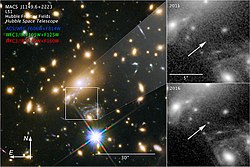Planetary System
| Companion (in order from star) | Mass | Semimajor axis (AU) | Orbital period (days) | Eccentricity | Inclination | Radius |
|---|---|---|---|---|---|---|
| b | 1.4 ± 0.4 M🜨 | 0.0441 ± 0.0008 | 5.240 ± 0.001 | — | 88.99 +0.68 −0.87 ° | 1.1 ± 0.1 R🜨 |
| c | 0.9 ± 0.3 M🜨 | 0.0576 ± 0.0009 | 7.775 ± 0.001 | — | 88.77 +0.70 −0.57 ° | 1.0 ± 0.1 R🜨 |
| d | 1.3 ± 0.4 M🜨 | 0.0685 ± 0.0012 | 10.115 ± 0.001 | — | 89.43 +0.38 −0.45 ° | 1.1 ± 0.1 R🜨 |
K2-239 has a system of three small, Earth-sized planets in a tight 2:3:4 orbital resonance chain. All of them are between 1.0 and 1.1 times the size of Earth, meaning they are very likely to be rocky. The discovery team estimated their masses to range from 0.9 M🜨 to 1.4 M🜨, consistent with a rocky composition for each of the planets. Due to their proximity to K2-239 they are all hot; however, because the host star is just 1.6% as luminous as the Sun, they are much cooler than if they were placed around the Sun. For albedoes of 0 they would have equilibrium temperatures of 502 K (229 °C; 444 °F) for K2-239b, 427 K (154 °C; 309 °F) for K2-239c, and 399 K (126 °C; 259 °F) for K2-239d. None of them are cool enough to host liquid water or be considered potentially habitable.


